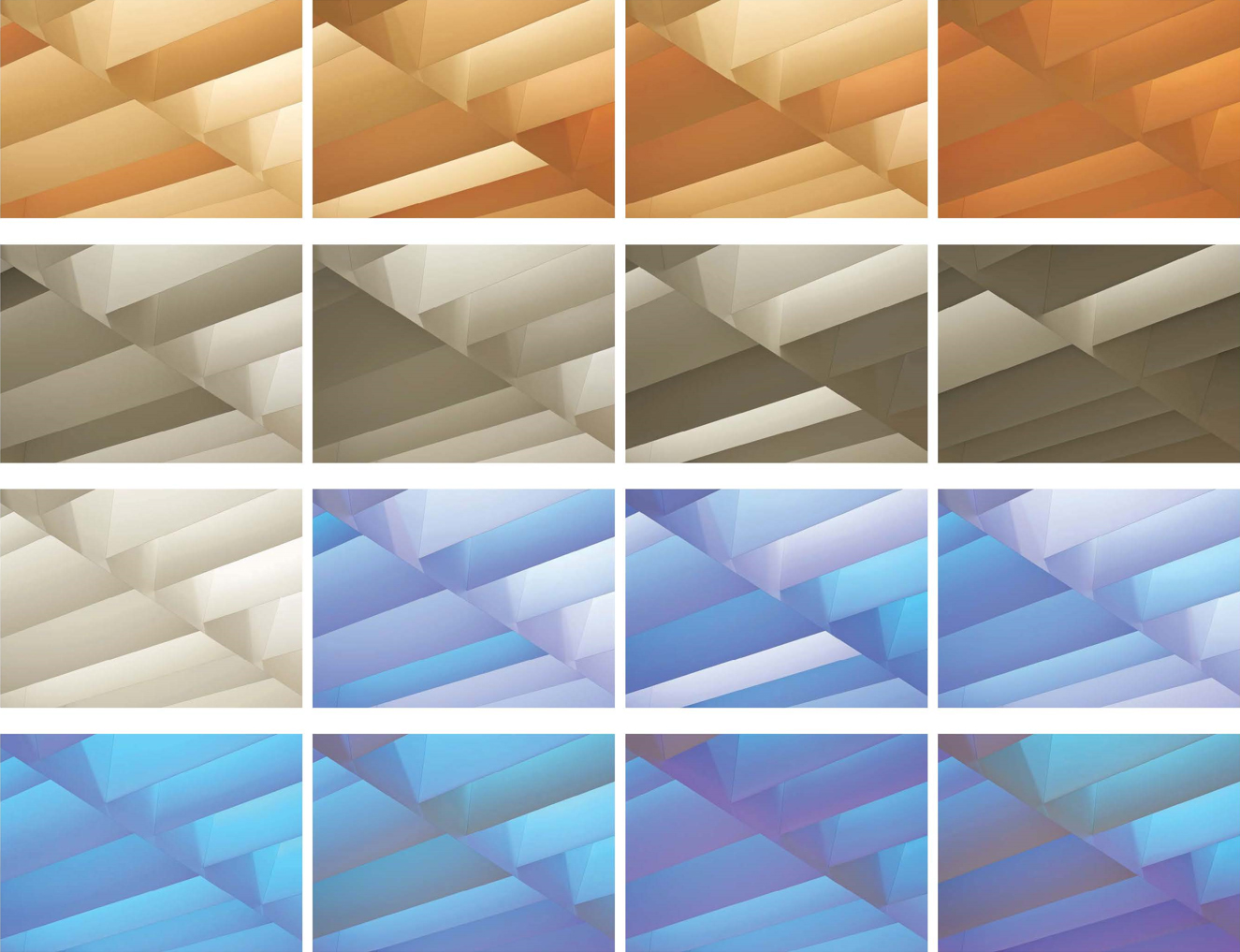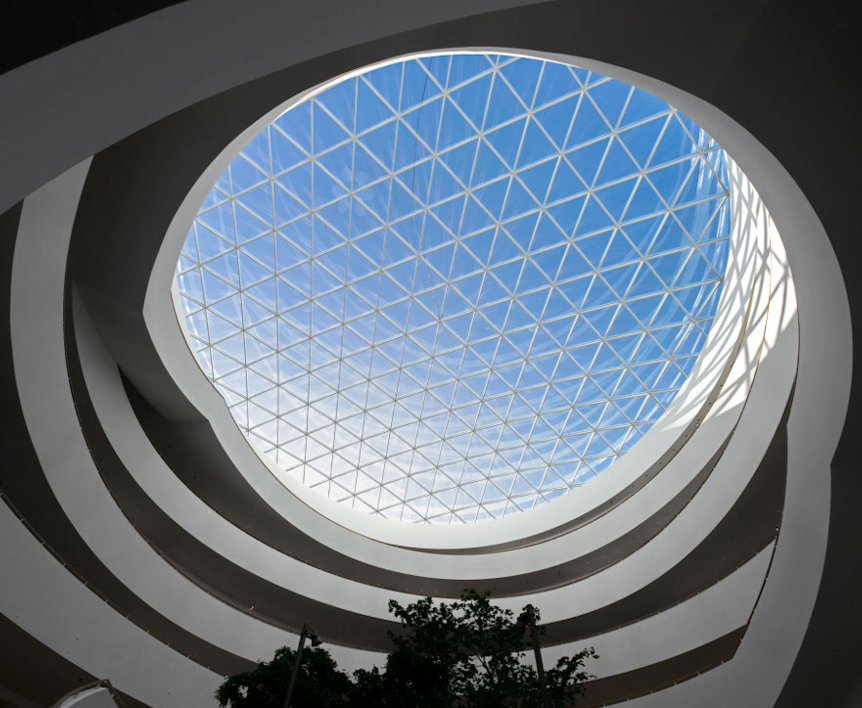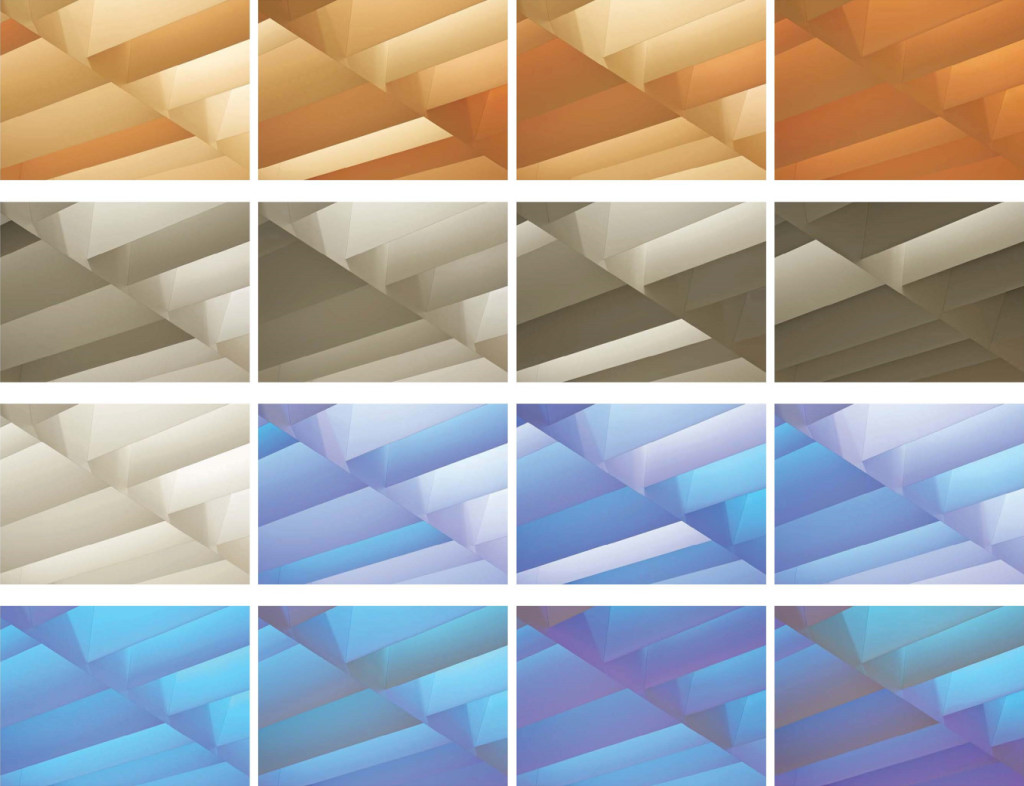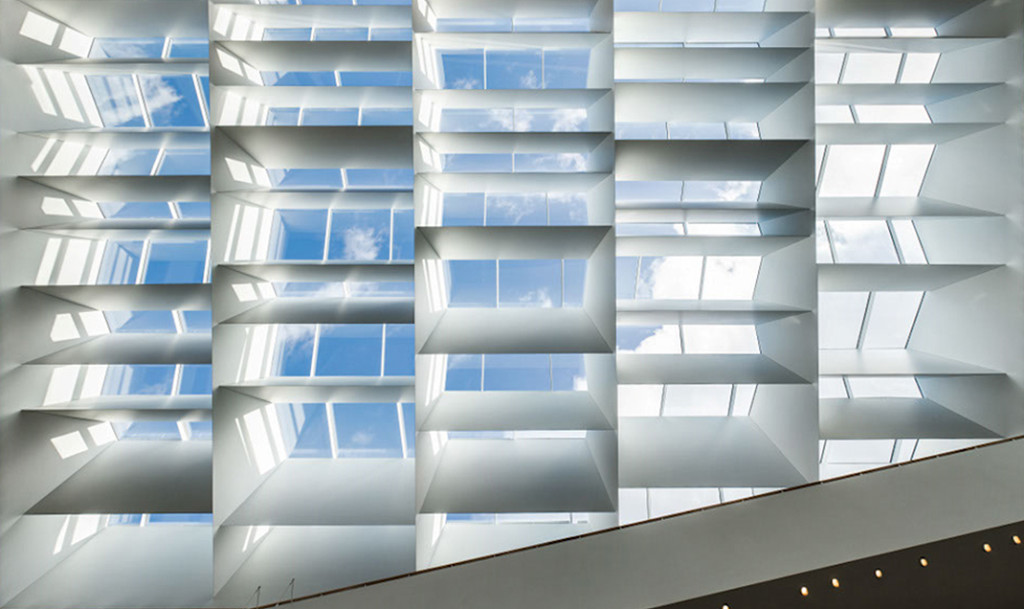
by Christina Augustesen
How can we design buildings that stimulate our senses, follow our human needs and allow us to live in balance with nature? Buildings, which combine the use of daylight and artificial light and use the “double dynamic” potential of controlling daylight and artificial light, might stimulate our senses and human needs, as well as enhance the feeling of living in balance with nature.
Christina Augustesen presenting “Architecture for the Senses” at the 6th VELUX Daylight Symposium in London.
The Sense of Light
Light is an important parameter for humans to sense and perceive the spaces surrounding them, and the character of the light in a given space can be seen to influence our mood and wellbeing. Light describes our environments – and light and shadow tell us about form, materials, texture, rhythm and history. To design buildings is to work with form and light. To work with a light aperture is to design not only the space´s lighting, but also its appearance and atmosphere. The interior is the reverse side of the exterior and the place where the atmosphere and character of the space is formed. A light aperture is not merely a communicator of exterior illumination, but probably the single most important element in the planning of a space´s visual environment.
The character of daylight – its intensity, direction, and colour – influences how spaces and objects are accentuated and perceived. These parameters are well know from nature, such as when the sun changes direction, intensity and colour throughout the day. Most humans know by heart how their surroundings change according to changes in light’s character: for example, how spaces and objects shift character when clouds cover the sun, creating diffuse daylight where shadows are dissolved in a second. Likewise, humans sense the dynamic from the changing of light under dynamic weather conditions, and when, for example, a tree canopy filter the sun and skylight to create a fluctuating dappled light. Humans sense these changes foremost via the eyes and the brain – and most often it reminds one of being close to nature and origins.
The fact that people spend more and more time in artificially illuminated environments makes it both worthwhile and essential to develop strategies that ensure such environments can still positively stimulate our senses and enhance our feelings of living in connection with nature. Here light plays an important role, and it is crucial that architectural ideas and concepts employ strategies for the use of daylight and artificial lighting. A lighting strategy should serve as a main, guiding concept that establishes a hierarchy between the daylighting and the artificial lighting elements. A lighting strategy helps to integrate lighting into buildings in natural ways so that in addition to meeting the functional needs the lighting helps to clarify and refine the spaces, create inspiring atmospheres, and positively influence experiences and comfort levels.
The Integration of a Lighting Strategy
The new Novo Nordisk Headquarter, located in Bagsværd, Denmark, consists of two main buildings NN1 and NN2, and is a notable example of how daylighting and artificial lighting are well integrated into the building design. The Headquarter is designed to create working spaces and recreational spaces, which are well lit by daylight. The office spaces are placed near to the façade, ensuring good daylight conditions in the working areas. And the apertures of the atrium are shaped to transport the daylight into the building in a poetic and unique way that creates an exciting and welcoming atmosphere.
The overall lighting strategy for the artificial lighting has its focus on accentuating the building’s iconic significance and identity, the movements and flows throughout the building, and the building’s appearance, and functionality during the daytime, evening, and night time hours. This has been achieved via a varied lighting environment, where orientation and movement are controlled by vertical lighting, the low placement of lighting elements, and variations in the lighting levels and lighting characteristics (for example, in variations in direct and diffuse lighting, and colour temperatures).
This specific lighting strategy has ensured sustainable lighting by prioritising the lighting’s illumination levels, placement, and control. The strategy has been an important design parameter throughout the entire design and construction processes, and the detailed planning followed the lighting strategy as well. Moreover, the strategy has been a crucial factor in interdisciplinary understandings and communications. The design and implementation of the lighting strategy was carried out in a close collaboration between the client, lighting designers, architects, interior designers, contractors, and suppliers – and the project-specific solutions were tested in onsite mock-ups. Based on the lighting strategy, lighting concepts were then developed for the atrium, auditorium, library, meeting rooms, canteen, and kitchenettes.
 Novo Nordisk NN1 Atrium | Photo Henning Larsen Architects
Novo Nordisk NN1 Atrium | Photo Henning Larsen Architects
A Ceiling Made of Light, Shadows, and Slow Dynamics
The second building of the Novo Nordisk Campus, NN2, offers a spectacular and sculptural atrium, offices, meeting rooms, a canteen, etc. Like building NN1, this building’s visible focal point is its atrium, which visually and physically connects the four floors and various functions. The atrium has been designed using 50 skylight baffles that poetically disperse daylight into the space – into the building’s core. The design and direction of the skylight baffles influence the play of light and shadow taking place throughout the day and across the year. Daylighting’s dynamic behaviour juxtaposed with the design of the artificial lighting’s intensity, direction, and colour temperature help to create the appearance of changing ‘ornamentation’ within the skylight baffles, as well as in the atrium and its adjacent spaces. On the occasions when daylight is insufficient – during evening hours and winter months – the artificial lighting comes to aid. The concept for the design of the artificial lighting entailed creating lighting that partly supports the daylighting during periods of limited natural light, and partly contributes to the general artificial lighting. Likewise, the artificial lighting has been designed to accentuate the tectonics of the skylight and to create a welcoming and exciting atmosphere in the atrium as a whole.
 Novo Nordisk NN2 Atrium | Photo Christina Augustesen
Novo Nordisk NN2 Atrium | Photo Christina Augustesen
The ’Double Dynamic’ potential
The shape of the atrium’s apertures and the building control system makes it possible to combine and regulate the resources of the daylight and the artificial lighting alike. Thus, it is possible to work with can be called a ‘double dynamic’ setup, which combines the natural dynamic of the skylight and daylight – as well as the dynamics that occur when the intensity and colour temperature of the artificial lighting are changed over time. Based on analyses of the colours of the sky and the ways that the variable colours of artificial light appear in contrast to these, a colour matrix for the artificial lighting was developed. Facts concerning the working hours of the employees and special days have also influenced the design of the artificial lighting.
The artificial lighting has been planned using ten different lighting scenarios; each programmed with a specific dynamic lighting configuration. The different colour shades shift in a slow tempo, characterised by a soft and gradual transition from one shade to another. Most of the scenarios work with white light nuances, which span a spectrum from bluish light to neutral white light, and finally to warm light in the form of dark golden hues. The scenes are programmed to align with the daytime lighting’s diurnal and seasonal rhythms, as well as to demarcate special days, such as the World Diabetes Day. The combination of the predictable dynamic of the artificial lighting and the unpredictable and dynamic changes of the daylight creates a ‘double dynamic’ that is never the same.
Conclusion
The character of the light and the way it is used and controlled is vital for human wellbeing. Holistic thinking regarding the use of daylighting and artificial lighting in concert can increase the quality of our surroundings and meet the varying demands of constantly changing lifestyles. The key is to balance and control the light in a rhythm and variation that makes us sense a dynamic without distracting us or stressing the mind and body. Lighting with a balanced change in light intensities and colours reminds us of being in connection with nature, whilst also stimulating our senses, elevating our mood, and improving general wellbeing.
 Novo Nordisk NN2 Atrium | Photo Henning Larsen Architects
Novo Nordisk NN2 Atrium | Photo Henning Larsen Architects
Christina Augustesen is an architect and lighting designer, and holds a Master in Architecture from The Royal Danish Academy of Fine Arts Schools of Architecture, Design and Conservation (KADK), Denmark and a master in Light and Lighting from Bartlett School of Architecture, UCL, UK. Christina has been working in the field of architectural lighting for more than ten years, in Denmark as well as internationally. Christina works with a holistic approach to lighting design, so that daylight and artificial lighting are embedded into sustainable solutions – integrating spatial, visual, aesthetic and technical aspects. She has a keen interest in artistic lighting installations and the study of visual perception, both of which play a key role in her on-going work. Christina has recently, in cooperation with Henning Larsen Architects, designed the lighting for Novo Nordisk new head quarter, DK, which was awarded the Danish Lighting Award 2014. Christina is a guest lecturer for Architectural Lighting at Copenhagen School of Architecture (KADK) and a member of TANTEIDAN and IALD.
References
1. Pallasmaa, Juhani, The Eyes of the Skin – Architecture and the Senses, John Wiley and Sons, 2012.
2. Dahl, Torben: Climate and Architecture, Routledge, Taylor & Francis Group, 2010, pp.115-119.
3. Tregenza, Peter: The Design of Lighting, London, Spon Press, 2004, pp.34-36.
4. Novo Nordisk Headquarter, Bagsværd, Denmark. Client: Novo Nordisk, Architect: Henning Larsen Architects (HLA), Lighting Designer: Grontmij’s Lighting Team in collaboration with HLA.
5. Itten, Johannes, The Elements of Color, Stuttgart, Urania Verlag, 2003.
6. Photo credit: Fig. 1-2, Søren Aagaard, Grontmij, Fig. 4, Christina Augustesen, Grontmij. Copyright Novo Nordisk. Fig. 3. Copyright Christina Augustesen, Grontmij.



